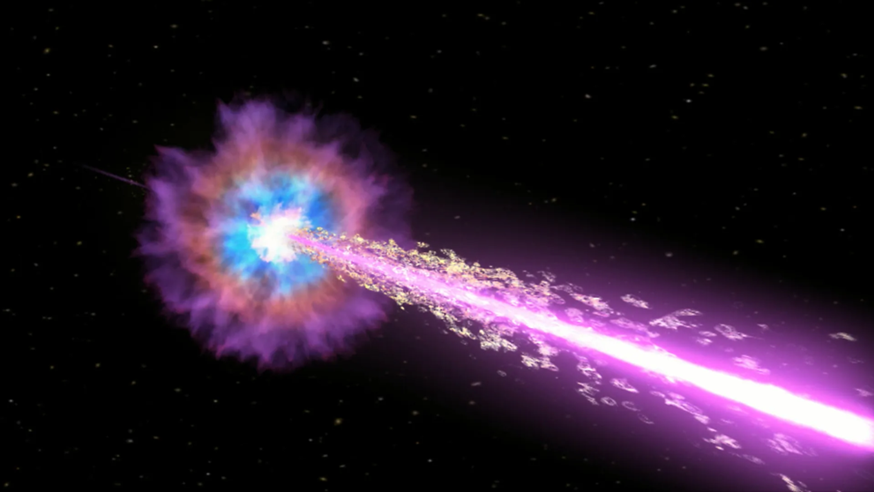According to new findings published in Nature Astronomy, a new type of star explosion offers a new approach to exploring the distant Universe. Lancaster University researchers collaborated with a global team led by Radboud University in the Netherlands to investigate ‘Fast X-Ray transients (FXTs),’ which are highly mysterious outbursts of X-ray radiation that normally last only a few minutes.

The jets pierce through the star, emitting X-rays and gamma rays as they stream into space. Image Credit: NASA/Swift/Cruz deWilde
We have known that these unique explosions exist for some time, but it is only now, thanks to the new Einstein Probe mission, that we can pinpoint them in near real time.
Peter Jonker, Study Second Author and Professor, Radboud University
Using observations from the Very Large Telescope in Chile and the Grantecan Telescope in Spain, the authors were able to pinpoint the Fast X-ray Transient's location in space. The initial position was provided by the Einstein Probe, an X-ray space telescope, and then refined on the ground using the ATLAS optical telescope.
These observations show that this explosion happened when the Universe was less than 10 per cent of its current age - the light has been travelling to us for 12 billion years. The combination of the distance and the brightness means this explosion gave off more energy in a few seconds than the Sun will over its entire life.
Andrew Levan, Study First Author and Professor, Radboud University
He added, “These extreme energies, along with the detection of gamma-rays by the Fermi satellite, suggest that the Fast X-ray Transients are related, at least sometimes, to the extremely powerful gamma-ray bursts that have been studied for half a century.”
“A real question is if all of the Fast X-ray Transients come from gamma-ray burst-like systems, or if there is much more diversity. Our paper shows that many of them might be gamma-ray bursts, but there are good reasons to think there is much more still to discover,” added Professor Jonker.
Examining the images from the Very Large Telescope revealed that there is very little material, notably hydrogen, surrounding the blast.
Hydrogen acts as a filter for ultraviolet light, preventing it from traveling through the universe.
However, during the time of this Fast X-ray Transient, the Universe saw its last major change in a process known as reionization, in which the hydrogen between galaxies was bombarded with ultraviolet light and ‘reionized.’
The difficulty is that almost all of the ultraviolet light produced by stars in the Universe is obscured by hydrogen in the galaxy in which they reside.
Our observations show that perhaps 10% of the ultraviolet light created in the host galaxy of the Fast X-ray Transient is escaping to ionize the Universe. This is the most distant event where we can directly see light escaping from around stars. Galaxies like this are probably really important for reionization.
Andrea Saccardi, Study Third Author and CNES Fellow, CEA Paris-Saclay
These findings pertain to one of the initial events that the Einstein Probe picked up on.
“In the year since this first object we have found and studied another 20 of these outbursts, they are living up to their promise as an exciting new way to explore both how stars end their lives, and also what the Universe was like in the distant past,” added Professor Levan.
Dr. Samantha Oates, a research co-author and Lancaster University Lecturer in Astrophysics, was a member of the research team.
She added, “This event is novel and interesting because only a handful of FXTs had been discovered until very recently, and their origin was a mystery, primarily because they had been found in archival observations. By the time they were discovered, it was too late to perform follow-up of these transient X-ray objects at other wavelengths to get other information about what might be causing them.”
According to Dr. Oates, the Einstein Probe, which was launched in January 2024, is revolutionizing the detection and follow-up of FXTs, which are now routinely discovered and the community is instantly notified, allowing for speedy follow-up.
She added, “The Einstein Probe has opened up a new window on the universe, allowing us to probe the origin of these transient X-ray phenomena and widen our knowledge of the behaviour associated with the deaths of massive stars.”
Journal Reference:
Levan, A. J., et al. (2025) Fast X-ray transient EP240315A from a Lyman-continuum-leaking galaxy at z ≈ 5. Nature Astronomy. doi.org/10.1038/s41550-025-02612-9.